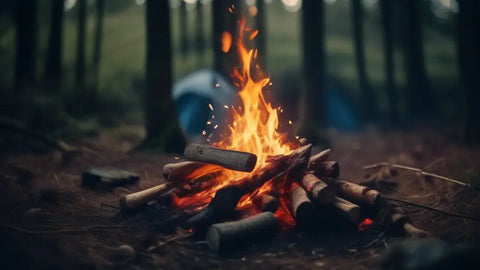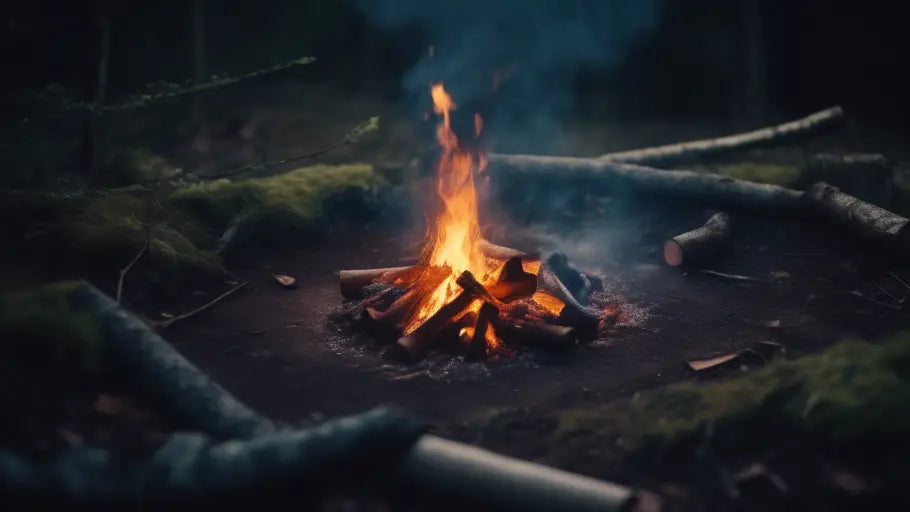A campfire under the stars – it's the quintessential image of camping, isn't it? A warm, crackling fire, the smell of wood smoke, the comforting glow illuminating the faces of loved ones sharing stories, all set against a backdrop of nature's nocturnal serenade. What could be more inviting?
The perfect campfire, however, isn't just about the flames – it's about the fuel behind them. The type of wood you choose can greatly influence your campfire experience, from the heat it generates to the aroma it imparts. Enter kiln-dried wood – the secret behind many a successful, memorable campfire.
But what makes kiln-dried wood the ideal choice for your next camping adventure? In this article, we delve into its benefits, how to choose the right type, and even some handy tips for building and maintaining your campfire. So, cozy up and read on!
Benefits of Kiln-Dried Wood for a Campfire

What is Kiln-Dried Wood?
Kiln-dried wood, as the name suggests, is wood that has been dried in a kiln – a type of large oven. During this process, the wood is slowly heated to a specific temperature to remove excess moisture, resulting in a product that’s dry, lightweight, and primed for burning.
The key characteristics of kiln-dried wood include a lower moisture content (typically below 20%), lighter weight, and a distinct, clean aroma. It's also generally free from pests and mold, thanks to the high temperatures it's exposed to during the drying process.
Advantages of Using Kiln-Dried Wood for a Campfire
Why choose kiln-dried wood for your campfire? Well, let us count the ways:
-
Higher heat output and efficiency: Thanks to its low moisture content, kiln-dried wood burns hotter and more efficiently than its green or air-dried counterparts. This means a cozier campfire and less wood consumed!
-
Reduced smoke and emissions: Lower moisture levels also result in less smoke – a real boon when you're sitting around the fire. Furthermore, it produces fewer emissions, making it a cleaner burning option.
-
Longer burn time: Kiln-dried wood tends to burn longer than other types of wood, providing you with a steady, reliable heat source for those long, storytelling-filled nights.
-
Easier to ignite and maintain: The dryness of kiln-dried wood makes it easier to light and keep burning, saving you the hassle of constantly tending to the fire.
-
Minimal sap and resin content: With most of the sap and resin cooked out during the drying process, kiln-dried wood is less likely to cause dangerous sparks or build-up in your fire pit.
Choosing the Right Kiln-Dried Wood for Your Campfire

Types of Kiln-Dried Wood
Just as there are many types of trees, there are many types of kiln-dried wood, each with its own burning characteristics. Some common types include oak, ash, and birch. If you fancy a fire with a pleasant aroma, consider kiln-dried pine – just be wary of its higher resin content.
When choosing between hardwood and softwood for your campfire, keep in mind that hardwoods like oak and ash burn hotter and longer, making them ideal for long nights. However, softwoods like pine ignite more easily, making them great for starting the fire.
You can find these and more in our collection of kiln-dried firewood.
Factors to Consider When Choosing Kiln-Dried Wood
When choosing your kiln-dried wood, look beyond just the type. Consider its moisture content (aim for below 20%), the density of the wood (hardwoods are denser and burn longer), and the size and shape of the firewood (smaller pieces ignite more quickly).
But let's not forget about sustainability. Opt for wood from a source that practices responsible forestry to ensure you're not contributing to deforestation. For more on this, check out our page on sustainable wood.
Where to Find Kiln-Dried Firewood
Kiln-dried firewood is as close as your local firewood supplier or a mere mouse-click away at online retailers. To ensure you're getting the real deal, look for wood that's visibly dry, lightweight, and has cracks at the ends – signs of properly kiln-dried wood.
Preparing and Building a Campfire with Kiln-Dried Wood

Campfire Safety Tips
Before we get into the actual building of the campfire, let's go over some safety guidelines. Always build your campfire in a designated fire pit or ring, keep a water source close by, and never leave the fire unattended. And remember to check local fire regulations – some areas prohibit campfires during certain times of the year.
Steps to Prepare and Build a Campfire
-
Clear the area: Brush away any flammable materials around your chosen fire spot.
-
Gather your materials: You'll need three types of firewood: tinder (small twigs or firelighters), kindling (small sticks or pieces of firewood), and fuel (larger pieces of firewood).
-
Build a fire foundation: Start with a small pile of tinder. Around this, build a tepee or log cabin structure with your kindling. Then add a few pieces of your kiln-dried fuel wood.
-
Ignite the fire: Light the tinder, and the fire should spread to the kindling and then the fuel wood.
-
Maintain the fire: As the fire burns, add more fuel wood as needed, making sure not to smother the flames.
Enhancing the Campfire Experience with Kiln-Dried Wood
Cooking Over a Kiln-Dried Wood Campfire
One of the joys of camping is cooking over an open fire. With kiln-dried wood's high, even heat, you can enjoy a variety of campfire-cooked meals, from skewered sausages to foil-wrapped veggies. Just remember to let the wood burn down to coals for the best cooking conditions.
Creating a Cozy Atmosphere with Kiln-Dried Wood
A campfire is more than a heat source – it's a social hub, a storytelling circle, a place of warmth and camaraderie. Enhance this atmosphere with the soft, mesmerising glow and crackling soundtrack of a kiln-dried wood fire. Add comfy seating, blankets, and maybe even some marshmallows for a truly unforgettable camping experience.
Campfire Maintenance and Cleanup
To ensure your campfire remains a source of comfort rather than concern, keep it at a manageable size, never leave it unattended, and extinguish it thoroughly before you turn in for the night or leave the campsite. When extinguishing, douse the fire with water, stir the ashes, and douse again, repeating until everything is cool to the touch.
Conclusion
In the great outdoors, where nature takes centre stage, a campfire is more than just a fire – it's a tradition, a gathering point, an essential part of the camping experience. And when it comes to building the perfect campfire, kiln-dried wood truly shines.
With its superior burn qualities, ease of use, and minimal environmental impact, kiln-dried wood can turn a good camping trip into a great one. So why not give it a try on your next adventure? After all, the perfect campfire is one that's built with care, thought, and of course, the right wood.

